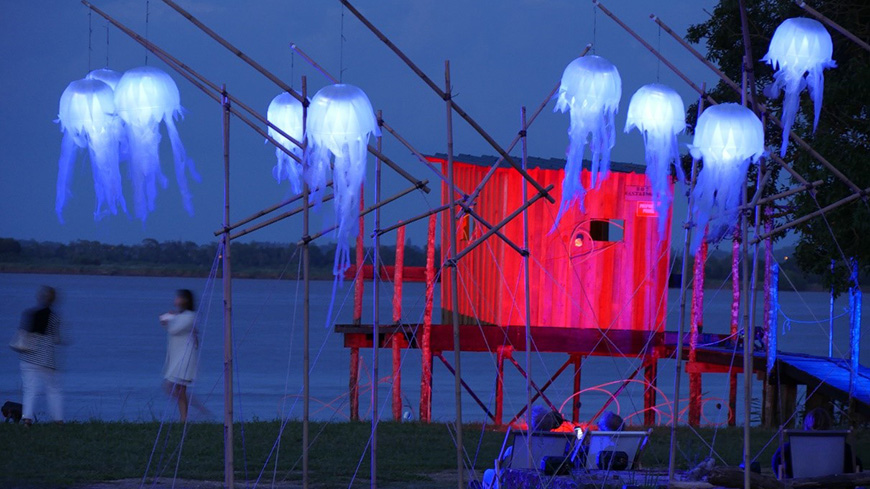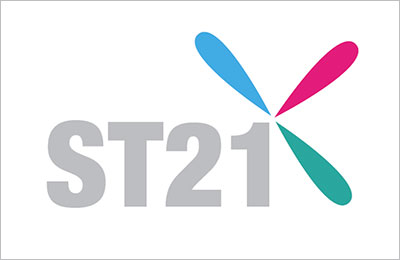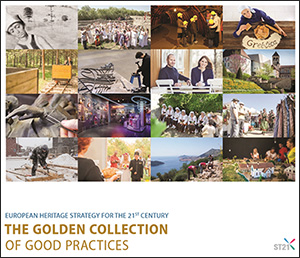Location of the initiative:

2 regions: Pays de la Loire and Nouvelle Aquitaine
Départements: Loire-Atlantique (44); Charente-Maritime (17); Gironde (33).
Towns: Pornic, Saint-Nazaire, Saint-Brevin-les-Pins, Saint-Michel-Chef-Chef, La Plaine-sur-Mer, Préfailles, La Bernerie-en-Retz, Les Moutiers-en-Retz, Fouras-les-Bains, Saint-Nazaire-sur-Charente, Port des Barques, Saint-Palais-sur-Mer, Arces-sur-Gironde, Talmont-sur-Gironde, Braud-et-Saint-Louis, Saint-Ciers-sur-Gironde, Saint-Julien-Beychevelle and Jau-Dignac-et-Loirac.
Initiator
Territoires imaginaires Association
Relation to Strategy 21 Recommendations:
K3 - encourage creativity to capture the attention of the heritage audience
Other recommendations present: S1, S2, D5, D7, D9, D10, K11, K3
Time span of the initiative:
Start date: June 2013
End date: ongoing
Motivation / Methodology
The Territoires imaginaires (Imaginary Territories) association was founded in July 2012. Its aim is to “promote local areas and regions through a collaborative approach with the artistic and cultural sectors”. Territoires imaginaires is particularly interested in the tangible and intangible heritage of regions in their relation to water, but can also focus on other environments, including urban, natural and industrial heritage.
Its approach consists in reflecting on what makes a region and the way of life of its inhabitants special and devising an innovative cultural and artistic programme to bring this to light [K3]. In connection with the cultural, environmental and tourism policies of local authorities, the association designs and organises events and activities to promote cultural and natural heritage sites, providing advice, project co-ordination services and training. These events and activities include: Les 100 ans de la ville de Trignac / L’eau de Là / Détour(s) à Paimboeuf / La Nature Pourrait Vous Plaire, La Grand’ Fabrique de l’imaginaire, etc.
Since its inception, Territoires imaginaires has worked to raise awareness of the carrelet fisheries dotted along the Atlantic coast. This little-known vernacular heritage, which consists of stilt-borne fishing huts equipped with square pulley-operated nets, is very popular although hard to reach [S2]. In 2013, Territoires imaginaires launched a new concept: La Nuit des Pêcheries (Night of the fisheries) in Pornic in the Loire-Atlantique region, the first of its kind in France. This flagship event has given rise to a range of different cultural and artistic events: La Nuit des pêcheries / La Nuit des carrelets / Les Voyages sonores / Carrelets en lumière / Pêcheries en lumière / Pêcheurs de rêves / Un Après-midi à la pêcherie. These now take place by day and by night, on a small footing, in locations that lie off the beaten track, working within the limits which the sites impose. The festival has gradually fanned out along the Atlantic Coast and up the estuaries of the Loire, Charente and Gironde rivers, and as it grows, it remains mindful of preserving the places where it is held [D9], and helps to build bridges between local stakeholders (elected officials, associations, private and public institutional partners, etc.) [S1].
The idea of a festival travelling along the Atlantic seaboard quickly emerged and the interest for this type of heritage in other countries – in Europe and beyond – was clear; the Itinérance Atlantique project naturally became part of the European Year of Cultural Heritage in 2018 and gained further prominence from that label.
Fisheries offer an excellent opportunity for raising public awareness of tangible cultural heritage as well as societal, environmental and ecological issues, using heightened spatial contextual awareness to pass on a message to the public about heritage and nature conservation and the like, and even encouraging audience members to take on a more active role in the community. Playing with different avenues of artistic expression, the events organised by Territoires imaginaires are an invitation to slow down, take a step back and enjoy a moment of contemplation and well-being.
Taking a new look at heritage by focusing on carrelet fisheries is drawing wider attention to these fragile coastal and estuarine landscapes and helping to improve understanding of their natural and cultural ecosystems.
We work on the basis that every event is an opportunity to produce a convivial exchange with the audience about a theme linked to the region in question. Our initiative serves to raise awareness of studies in partnership with specialised organisations, thus providing a link between the public and the latest knowledge of these very special environments tucked between land and sea [K11].
Territoires imaginaires builds directly on the Council of Europe’s Strategy 21 (European Cultural Heritage Strategy in the 21st Century, 2017) which corresponds to and even reinforces the values the association upholds.
Obstacles / Barriers
Unlike institutional bodies which work for local authorities and have a specific budget for project development or associations which benefit from a stable income through annual budgets allocated on a recurrent basis, the Territoires imaginaires association must seek funding for each project it brings about.
These funds are needed to pay the association’s running costs, entertainment industry professionals and freelancers (schedulers, co-ordinators, administrators, artists, technicians, graphic designers, communication and press relations officers, etc.).
Project funding sometimes involves collaboration between up to six public partners (including, for example, Europe, central government, regions, départements, communities of municipalities/agglomeration communities and individual towns). The various promises of support are staggered over time and sometimes come in only a little ahead of the events themselves. In some cases, the association has to wait two to three years before receiving grants (e.g. from the European LEADER programme), which undermines its financial stability.
Furthermore, while our activities reach across disciplines to meet high public expectations and fall in line with European cultural policy, this overarching approach encompassing heritage, performing arts, street and public space arts, the environment and tourism becomes a major barrier to obtaining funding from local authorities whose funding schemes are often linked to policies largely based on a sectoral view that excludes such interdisciplinarity.
Such obstacles mean that the Territoires imaginaires association is unable to meet all of its personnel needs. Tasks are shared between two main positions, with one responsible for running the association and the other for scheduling and co-ordinating its projects. In addition to these main lines of work – designing and programming events in local areas, finding individual funding for each of them and co-ordinating their implementation – the team at times finds itself overwhelmed by tasks which by all accounts should be delegated. Keeping the artistic programme on track from start to finish is also complex and full of twists and turns. Nothing can ever be taken for granted and it is often hard to deal with such uncertainty.
However, as our projects gradually bring local areas on board, gaining the trust of partners and local authorities, commissioning artists and winning calls for projects, the support and commitment of the association’s board and of the artistic and technical teams are key assets for building our future and making our projects sustainable. This leads us to hope that we will soon be able to spend more time on our core activities and the association’s development.
Difficulties, barriers to the European dimension of the project
For several years now, we have been working to set up co-operation with other European Union countries because we know that the carrelet fisheries are a shared heritage, which can particularly be found in Italy. However, we have been met with a series of barriers and obstacles of various kinds which have prevented us from being successful so far.
We have found it hard to understand and join existing schemes (Interreg, Erasmus +, etc.), which are useful for developing co-operation activities between the regions of Nouvelle Aquitaine and Emilia-Romagna, for example. While our project may be eligible under certain criteria, the location of our association’s headquarters could, however, lead to its being rejected because of the demand for “local or regional preference”.
We regretted a contradiction that existed between the goal of the European Year of Cultural Heritage in 2018, in which we participated (label obtained by the French Ministry of Culture in two regions: Pays de la Loire and Nouvelle Aquitaine), and the eligibility criteria for European funding.
Our priority would initially be to benefit from mobility aid in order to meet with possible partners abroad, then to design and implement a European project while receiving support in putting together a dossier.
Change / Impact
For years, we have been travelling through regions in search of their identity. We have discovered new landscapes which are home to people from all walks of life, meeting with elected officials, experts and ordinary citizens, the young and old, and adults in active working life and in retirement. This experience has enriched our knowledge of different local areas and inspired us to create different kinds of events to raise the profile of and promote these regions.
Our presence on the ground has raised public awareness of local heritage and also triggered changes in public behaviour – even leading local and regional organisations to alter their approach.
This has enabled us to set up steering committees in several local areas. Bringing together elected officials, experts from partner communities, representatives from the tourist industry and associations, they provide a forum for encouraging stakeholder participation, co-ordinating events and building relationships over the long term.
Events to promote the carrelet fisheries would not be possible without the authorisation of the institutions managing them (Grand Port Maritime, Département Directorate for Land and Sea Use, French Waterways Authority, etc.) or the support of associations representing owner-occupiers of carrelet fisheries in the Atlantic Arc (Association des Pêcheurs au Carrelet de l’Estuaire de la Gironde, Les Cabaniers du Médoc, Les Carrelets Charentais and Association pour la Conservation des Pêcheries Traditionnelles de la Côte de Jade).
We have been working closely with these associations from the outset. They put us in touch with their members so that we can draw up agreements to promote the fisheries, open their doors to the public and organise artistic events in and around the fishing huts. When our events take place, the associations call on their members to welcome visitors into the fisheries to find out more about this particular practice. We have also noticed that some carrelet fisheries have been restored in the wake of our events. Our actions are indirectly contributing to the restoration of this fragile heritage.
Several of the associations brought together through our work went on to found in 2019 the Union des carrelets de l’Arc Atlantique (Atlantic Arc Carrelet Union), whose main objective is to protect the fisheries and promote their recognition as part of our cultural heritage.
Such co-operation, facilitated by Territoires imaginaires, is very much to the benefit our audience: families, people of all ages, local residents and tourists alike. It should be stressed here that the idea behind the events to promote the landscapes and carrelet fisheries of the Atlantic Arc is to invite people to take a fresh look at this heritage, to let the poetic magic of the moment gently lull them into contemplating, questioning and reflecting on the environment around them and its preservation.
Over the years, we have become victims of our own success in some places; although just a few hundred people attended our events at the beginning, these days, they attract thousands of visitors. While this “over-attendance” brings a large number of visitors to the regions in question, much to our partners’ delight, there is also a danger of this coming into conflict with our original goal. We must now work with these partners to consider ways to adapt our work going forward.
Lessons learned
When we first came up with and tested the idea of using the arts to promote the carrelet fisheries in Pornic in 2013, this was an entirely new approach. We ran into difficulties in our own region, Pays de Loire, because people found it hard to believe that this endeavour held promise and would appeal to the public. By contrast, when we started working in other regions in the Atlantic Arc, our partners were more open to the idea and quickly understood its benefits from a cultural and tourist angle.
By 2019, 18 towns were putting on events we had organised, compared to just one municipality in Pays de la Loire in 2013, followed by three in Nouvelle Aquitaine a year later. In 2020, two new towns in the Gironde département, Le Tourne and Langoiran, were also to host the travelling festival (Itinérance Atlantique - La route des pêcheries au carrelet).
What was supposed to be a one-off event has turned into an annual affair. From 2013 to 2019, nearly 105 000 people attended our gatherings, including 17 500 who went to visit or take part in an artistic event held in the carrelet fisheries. These figures do not take into account attendance in 2020 because most of the events were postponed or cancelled owing to the COVID-19 pandemic.
In addition to its primary aim, the effects of our approach on awareness of carrelet fisheries and their upkeep have been manifolded. Institutional managers and central government representatives have noted how our activities have encouraged the gradual restoration of this heritage.
Moreover, local associations are proud to be part of our events, which enable them to raise the profile of their own actions to promote the fisheries.
Lastly, some local authorities have come to understand the added value of these events in terms of culture, art and tourism; they have noted how we have built up loyal following eager to come back year after year.
Media coverage of our activities has also taken off, with countless articles in the local press providing us with good publicity both prior to and following events held across the region. Thanks to this, readers throughout départements know about the events we organise in small rural communities.
Studies are also underway. In 2018, Loïc Ménanteau, a researcher at the National Centre for Scientific Research (CNRS) in France, and Claire Giraud-Labalte, President of Territoires Imaginaires and of Pôle Patrimoine, a cultural heritage co-operation network in Pays de la Loire, started mapping the distribution of carrelet fisheries in the municipalities along the coast and estuaries of France’s Atlantic seaboard. Entitled “Carrelet fisheries: a fragile heritage worth promoting”, the map will be published as a double-page spread in a special issue of Atlas bleu - Revue cartographique des mers et des littoraux on Coastal and Maritime Heritage, which will be available online in bilingual format (French and English) from the end of 2020.
Furthermore, our work lighting up carrelet fisheries by night has been a source of inspiration for both professional and amateur photographers. Their images have featured in an exhibition and many of them are being shared on social networks.
We are also regularly contacted by performing, visual and sound artists who wish to organise low-key performances in these unusual huts, which are generally no larger than 9 square metres.
Ultimately, when we launched the first Nuit des pêcheries au carrelet in 2013, we had no idea what its future impact would be. These small huts perched on stilts above the water were the starting point of an exciting and enriching human undertaking.
Today, our goal remains unchanged: to continue to create cultural and artistic projects accessible to a broad audience. Working from a given region, seeking to involve this audience by inviting it to go off the beaten track and widen its horizons, casting a new light on the landscapes around us and finding better ways of living together.
Over time, weaving ties between Culture, Regions and Communities has become a course to stick to, a passion. Creating exchanges at the confluence of heritage, local residents, the arts and coastal regions is the star by which Territoires imaginaires navigates.
Online resources
Contact information
Contact person: Christophe Guiho
Organisation: Territoires imaginaires
Address: Atelier 9, 44000 Nantes, France
Email: [email protected]
Website: http://territoires-imaginaires.fr/
Facebook: https://www.facebook.com/Territoires-imaginaires-394991843952141
Source of financing
Public financing





